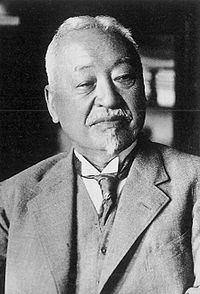- Masuda Takashi
-
Masuda Takashi
益田 孝
Masuda TakashiBorn November 12, 1848
Sado Island, Niigata prefecture, JapanDied December 28, 1938 (aged 90) Nationality Japan Occupation Entrepreneur Baron Masuda Takashi (益田 孝, November 12, 1848 – December 28, 1938), was an entrepreneur in Meiji, Taishō and early Shōwa period Japan, responsible for transforming Mitsui into a zaibatsu through the creation of a general trading company, Mitsui Bussan. He also established a newspaper, the Chugai Shōgyō Shimpō (中外商業新報), which was later renamed the Nihon Keizai Shimbun.
Contents
Biography
Masuda was born on Sado Island, in what is now Niigata Prefecture. His father was an official in the Tokugawa Bakufu, serving as Hakodate bugyō, a position which involved in dealing with foreigners and foreign trade as the sakoku national isolation policy ended in the Bakumatsu period. During this period, the American Consulate General Townsend Harris was based at Zenpuku-ji in Azabu. Takashi served as an interpreter there at the age of 14.
Masuda accompanied Ikeda Nagaoki in the unsuccessful 1863 Second Japanese Embassy to Europe to negotiate the cancellation of the open-port status of Yokohama. On his return he studied English at the Hepburn School (the forerunner of Meiji Gakuin University).
In 1871, after the Meiji restoration, Masuda obtained a job at the Ministry of Finance through his personal connections with Inoue Kaoru. He served as Master of the Mint, but resigned in 1873. In 1874, Masuda established the Senshu Kaisha trading company in Yokohama with Inoue’s support. In 1876, at the age of 29, Masuda was appointed the president of Mitsui Trading Company (Mitsui Bussan Kaisha) and contributed to the development of the Mitsui zaibatsu . Mitsui quickly became a dominant player in Japanese exports of silk cloth and thread, cotton, coal, and rice, and in the import of industrial products and weaponry.
Masuda negotiated with the Ministry of Industry to acquire ownership of the Miike coal mines at very favorable prices when the government decided to divest itself of industries. This became the subsidiary company, Mitsui Mining Company, in 1889, with Dan Takuma as president. In 1900, he created the Taiwan Sugar Corporation, beginning Mitsui’s expansion into Japanese overseas colonies. By the 1910s, Mitsui had developed into Japan’s largest general trading company, accounting for nearly 20% of Japan’s total trade.
Masuda formally retired in 1913, and devoted his energies towards the Japanese tea ceremony. He had residences in Odawara and Kamakura, where he hosted tea ceremonies. In 1918, he was elevated in rank of baron (danshaku) in the kazoku peerage system.
Masuda died in 1938, and his grave is at the Buddhist temple of Gokoku-ji in Tokyo.
Masuda’s daughter, Uryu Shigeko, accompanied Tsuda Umeko to the United States, and along with Tsuda, devoted her life to furthering education for women in Japan. His son, Masuda Tarokagyu, was a noted playwright.
Filmography
- (踊る龍宮城 Odoru ryū kyūjō, literally "Dancing Dragon Palace") (1949)
References
- Guth, Christine. Art, Tea and Industry: Masuda Takashi and the Mitsui Circle. Princeton University Press (1993) ISBN 0691032068
- Fujiyama, Kiyoshi. The House of Mitsui. The Tokyo Observor, 1932, ASIN: B0008AWR3K
External links
Categories:- 1848 births
- 1938 deaths
- People from Sado
- Kazoku
- Japanese businesspeople
- People in Meiji period Japan
- Japanese tea masters
Wikimedia Foundation. 2010.
